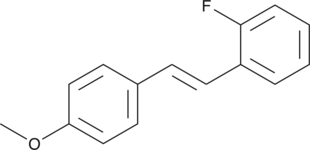Description
An inhibitor of mitochondrial complex I; inhibits NADH/DB oxidoreductase and NADH oxidase (IC50s = 28.8 and 5.1 nM, respectively); increases ROS production in the mitochondria of substantia nigra pars compacta neurons; induces Parkinson-like neuropathology and behavior in rodents; reduces tyrosine hydroxylase levels in the posterior striatum and prefrontal cortex, induces catalepsy, and decreases spontaneous locomotion and exploration in the open field test in rats at 1.5 and 2.5 mg/kg per day for two months; commonly used as a model of Parkinson’s in rodents
Formal name: (2R,6aS,12aS)-1,2,12,12a-tetrahydro-8,9-dimethoxy-2-(1-methylethenyl)-[1]benzopyrano[3,4-b]furo[2,3-h][1]benzopyran-6(6aH)-one
Synonyms: Nicouline|NSC 26258|NSC 8505|Tubatoxin
Molecular weight: 394.4
CAS: 83-79-4
Purity: ≥95%
Formulation: A crystalline solid
Product Type|Biochemicals|Ion Channel Modulation|Activators||Product Type|Biochemicals|Ox Stress Reagents|Free Radical Generators||Product Type|Biochemicals|Pesticides|Insecticides||Product Type|Biochemicals|Small Molecule Inhibitors|MMPs||Product Type|Biochemicals|Small Molecule Inhibitors|Oxidative Phosphorylation||Research Area|Cell Biology|Mitochondrial Biology||Research Area|Neuroscience|Neurodegenerative Disorders|Parkinson’s Disease||Research Area|Toxicology|Cell Health & Viability|Mitochondrial (dys)Function||Research Area|Toxicology|Environmental




